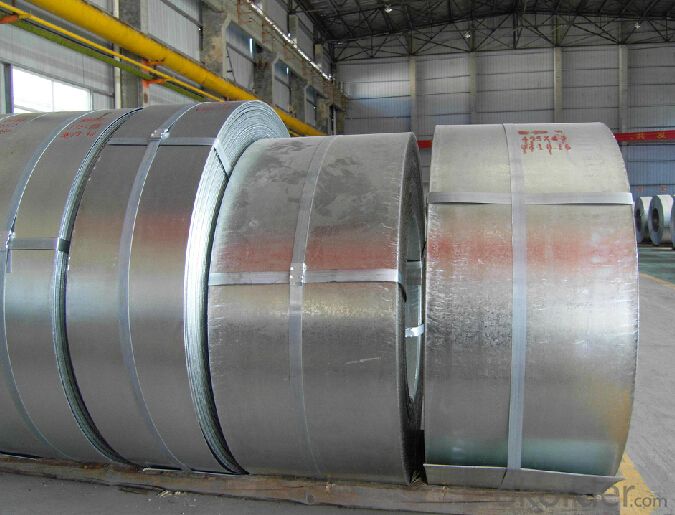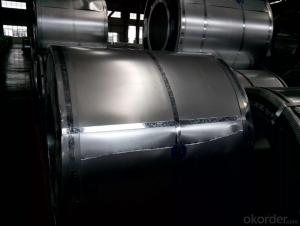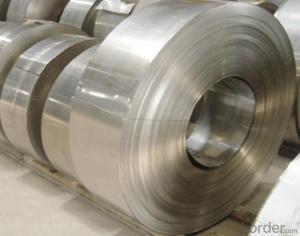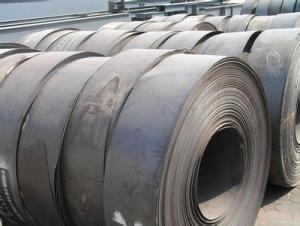Best Cold Rolled Steel Coil JIS G 3302 Walls Steel Coil ASTM 615-009
- Loading Port:
- Tianjin
- Payment Terms:
- TT OR LC
- Min Order Qty:
- 33 kg/m²
- Supply Capability:
- 11 kg/m²/month
OKorder Service Pledge
OKorder Financial Service
You Might Also Like
1.Structure of Cold Rolled Steel Description:
The raw material of cold rolled steel coil/sheet is high quality hot rolled product, and after pickling continuous rolling, degreasing, annealing,skin pass,slitting and cut to length line etc. Along with it many kinds of new technology and new process of global cold rolling production have been applied. Therefore the quality of the goods could be guaranteed. The product is widely used in outdoor and interior decoration, furnishing manufacturing, home appliance, automobile etc. it has a lower melting point than steel and good castability properties.[1] Certain compositions of cast iron, while retaining the economies of melting and casting, can be heat treated after casting to make malleable iron or ductile iron objects. Steel is also distinguishable from wrought iron (now largely obsolete), which may contain a small amount of carbon but large amounts of slag.
2.Main Features of the Cold Rolled Steel:
• Excellent process capability
• Smooth and flat surface
• Workability, durability
• Excellent heat resistance performance
• High strength
• Good formability
• Good visual effect
3.Cold Rolled Steel Images

4.Cold Rolled Steel Specification
Standard:AISI,ASTM,DIN,GB,JIS,JIS G3302 ASTM 653M EN10142
Grade: Q195~Q345
Thickness: 0.16mm~1.5mm,0.16-1.5mm
Width: 1250,600-1250mm
Coil weight:3-12 MT
Coil ID:508/610mm
Chemical composition:
C | Si | Mn | Cr | Ni | P | S |
0.150 | 0.476 | 11.231 | 12.50 | 0.900 | 0.039 | 0.010
|
5.FAQ of Cold Rolled Steel
We have organized several common questions for our clients,may help you sincerely:
1.How about your company?
A world class manufacturer & supplier of castings forging in carbon steel and alloy steel,is one of the large-scale professional investment casting production bases in China,consisting of both casting foundry forging and machining factory. Annually more than 8000 tons Precision casting and forging parts are exported to markets in Europe,America and Japan. OEM casting and forging service available according to customer’s requirements.
2.How to guarantee the quality of the products?
We have established the international advanced quality management system,every link from raw material to final product we have strict quality test;We resolutely put an end to unqualified products flowing into the market. At the same time, we will provide necessary follow-up service assurance.
3. How long can we receive the product after purchase?
Usually within thirty working days after receiving buyer’s advance payment or LC. We will arrange the factory manufacturing as soon as possible. The cargo readiness usually takes 15-25 days, but the shipment will depend on the vessel situation.
- Q:Are steel strips suitable for low-temperature applications?
- Yes, steel strips are suitable for low-temperature applications. Steel has excellent strength and toughness even at low temperatures, making it a reliable material for various applications in cold environments.
- Q:Are steel strips resistant to abrasion or scratching?
- Yes, steel strips are highly resistant to both abrasion and scratching due to their durable and hard nature.
- Q:Can steel strips be used in solar panel frames?
- Yes, steel strips can be used in solar panel frames. Steel is a strong and durable material that can provide the necessary structural support for solar panels. It is commonly used in the construction of solar panel frames due to its strength, cost-effectiveness, and ability to withstand various weather conditions.
- Q:Can steel strips be used for making precision stampings?
- Yes, steel strips can be used for making precision stampings. Steel strips are often used in stamping processes due to their strength, durability, and ability to maintain tight tolerances. Precision stampings require accurate and consistent shaping of the metal, and steel strips provide the necessary stability and uniformity for such applications. Additionally, steel strips can be customized to different thicknesses, widths, and alloys to meet specific requirements, making them versatile for various precision stamping projects.
- Q:Can cold rolled strip be plated with white zinc?
- Rust removal will affect the quality of the plating. The rusted part must be polished with sandpaper to allow it to be the same as the surface roughness without rust around it.
- Q:What are the common applications of galvanized steel strips?
- Galvanized steel strips have a wide range of applications due to their durable and corrosion-resistant properties. Some common applications of galvanized steel strips include: 1. Construction industry: Galvanized steel strips are widely used in the construction industry for various purposes. They are used in the production of roofing sheets, gutters, downspouts, and flashings. The corrosion resistance of galvanized steel strips makes them ideal for outdoor construction projects. 2. Automotive industry: Galvanized steel strips are used in the automotive industry to manufacture parts such as car bodies, chassis, and structural components. The corrosion resistance of galvanized steel strips helps to prolong the lifespan of these automotive parts and ensures their durability. 3. Electrical industry: Galvanized steel strips are used in electrical enclosures, switchboards, and cable trays. The galvanized coating provides protection against corrosion and ensures the safety and longevity of electrical equipment. 4. Manufacturing industry: Galvanized steel strips are widely used in the manufacturing industry for various applications. They are used to make metal furniture, storage units, cabinets, and shelving systems. The corrosion resistance of galvanized steel strips helps to maintain the structural integrity and appearance of these products. 5. Agricultural industry: Galvanized steel strips are commonly used in agricultural applications. They are used to make fences, gates, and animal enclosures, as the galvanized coating provides protection against rust and enhances the longevity of these structures. 6. HVAC industry: Galvanized steel strips are used in HVAC (Heating, Ventilation, and Air Conditioning) systems for ductwork, air handling units, and exhaust systems. The galvanized coating ensures that these systems can withstand harsh environmental conditions and remain corrosion-free. 7. Packaging industry: Galvanized steel strips are used in the packaging industry to manufacture metal packaging containers, such as drums and barrels. The galvanized coating provides a protective barrier against corrosion, ensuring that the contents of the containers remain safe and secure. Overall, the common applications of galvanized steel strips span across various industries and sectors, thanks to their corrosion resistance, durability, and versatility.
- Q:How are steel strips processed for slitting into narrower widths?
- To create narrower steel strips, mechanical operations are utilized to process steel strips. The initial step involves uncoiling the steel strip from a large coil and feeding it into a slitter machine. This machine contains multiple circular blades that are spaced apart based on the desired width of the final strips. While the steel strip passes through the slitter machine, the circular blades rotate and cut the strip into narrower widths. The width of each strip is determined by the distance between the circular blades. To ensure the steel strip remains taut throughout the process and avoid any buckling or creasing, the slitter machine is equipped with a tensioning system. Following the slitting process, the steel strip undergoes additional processes to refine and finish the strips. These processes may include edge trimming, where any uneven or rough edges are removed to achieve smooth and precise edges. Additionally, the strips may be leveled to eliminate any residual stresses and maintain flatness. Once all the necessary processing steps are completed, the narrower steel strips are recoiled and packaged for shipment or further processing. The slitting process allows for the production of multiple narrower strips from a single large coil, enhancing the versatility and usability of the steel in various applications. In summary, the processing of steel strips for slitting into narrower widths involves precise cutting, edge trimming, leveling, and recoiling to produce strips that meet specific width requirements and quality standards.
- Q:What are the environmental considerations for steel strips?
- Some environmental considerations for steel strips include the energy consumption and emissions associated with the production process, the depletion of natural resources used in steel production, the potential for pollution and waste generation, and the end-of-life disposal or recycling options for steel strips. Additionally, the transportation and logistics involved in the supply chain of steel strips can contribute to carbon emissions and environmental impacts.
- Q:How are steel strips processed for electrical conductivity?
- Steel strips are typically processed for electrical conductivity through a combination of annealing, plating, and coating techniques. Annealing helps to reduce the steel's resistance by heating it and then slowly cooling it, which rearranges the crystal structure and aligns the grains. Plating with materials like tin or zinc enhances conductivity by providing a protective layer and reducing oxidation. Coating the steel strip with insulating materials, such as enamel or varnish, further improves electrical conductivity by preventing any short circuits or leakage.
- Q:Can steel strips be used in the manufacturing of boat hulls?
- Yes, steel strips can be used in the manufacturing of boat hulls. They are commonly used in larger vessels due to their strength, durability, and ability to withstand harsh marine environments.
1. Manufacturer Overview |
|
|---|---|
| Location | |
| Year Established | |
| Annual Output Value | |
| Main Markets | |
| Company Certifications | |
2. Manufacturer Certificates |
|
|---|---|
| a) Certification Name | |
| Range | |
| Reference | |
| Validity Period | |
3. Manufacturer Capability |
|
|---|---|
| a)Trade Capacity | |
| Nearest Port | |
| Export Percentage | |
| No.of Employees in Trade Department | |
| Language Spoken: | |
| b)Factory Information | |
| Factory Size: | |
| No. of Production Lines | |
| Contract Manufacturing | |
| Product Price Range | |
Send your message to us
Best Cold Rolled Steel Coil JIS G 3302 Walls Steel Coil ASTM 615-009
- Loading Port:
- Tianjin
- Payment Terms:
- TT OR LC
- Min Order Qty:
- 33 kg/m²
- Supply Capability:
- 11 kg/m²/month
OKorder Service Pledge
OKorder Financial Service
Similar products
New products
Hot products
Related keywords



























